Allstate 2013 Annual Report Download - page 273
Download and view the complete annual report
Please find page 273 of the 2013 Allstate annual report below. You can navigate through the pages in the report by either clicking on the pages listed below, or by using the keyword search tool below to find specific information within the annual report.-
 1
1 -
 2
2 -
 3
3 -
 4
4 -
 5
5 -
 6
6 -
 7
7 -
 8
8 -
 9
9 -
 10
10 -
 11
11 -
 12
12 -
 13
13 -
 14
14 -
 15
15 -
 16
16 -
 17
17 -
 18
18 -
 19
19 -
 20
20 -
 21
21 -
 22
22 -
 23
23 -
 24
24 -
 25
25 -
 26
26 -
 27
27 -
 28
28 -
 29
29 -
 30
30 -
 31
31 -
 32
32 -
 33
33 -
 34
34 -
 35
35 -
 36
36 -
 37
37 -
 38
38 -
 39
39 -
 40
40 -
 41
41 -
 42
42 -
 43
43 -
 44
44 -
 45
45 -
 46
46 -
 47
47 -
 48
48 -
 49
49 -
 50
50 -
 51
51 -
 52
52 -
 53
53 -
 54
54 -
 55
55 -
 56
56 -
 57
57 -
 58
58 -
 59
59 -
 60
60 -
 61
61 -
 62
62 -
 63
63 -
 64
64 -
 65
65 -
 66
66 -
 67
67 -
 68
68 -
 69
69 -
 70
70 -
 71
71 -
 72
72 -
 73
73 -
 74
74 -
 75
75 -
 76
76 -
 77
77 -
 78
78 -
 79
79 -
 80
80 -
 81
81 -
 82
82 -
 83
83 -
 84
84 -
 85
85 -
 86
86 -
 87
87 -
 88
88 -
 89
89 -
 90
90 -
 91
91 -
 92
92 -
 93
93 -
 94
94 -
 95
95 -
 96
96 -
 97
97 -
 98
98 -
 99
99 -
 100
100 -
 101
101 -
 102
102 -
 103
103 -
 104
104 -
 105
105 -
 106
106 -
 107
107 -
 108
108 -
 109
109 -
 110
110 -
 111
111 -
 112
112 -
 113
113 -
 114
114 -
 115
115 -
 116
116 -
 117
117 -
 118
118 -
 119
119 -
 120
120 -
 121
121 -
 122
122 -
 123
123 -
 124
124 -
 125
125 -
 126
126 -
 127
127 -
 128
128 -
 129
129 -
 130
130 -
 131
131 -
 132
132 -
 133
133 -
 134
134 -
 135
135 -
 136
136 -
 137
137 -
 138
138 -
 139
139 -
 140
140 -
 141
141 -
 142
142 -
 143
143 -
 144
144 -
 145
145 -
 146
146 -
 147
147 -
 148
148 -
 149
149 -
 150
150 -
 151
151 -
 152
152 -
 153
153 -
 154
154 -
 155
155 -
 156
156 -
 157
157 -
 158
158 -
 159
159 -
 160
160 -
 161
161 -
 162
162 -
 163
163 -
 164
164 -
 165
165 -
 166
166 -
 167
167 -
 168
168 -
 169
169 -
 170
170 -
 171
171 -
 172
172 -
 173
173 -
 174
174 -
 175
175 -
 176
176 -
 177
177 -
 178
178 -
 179
179 -
 180
180 -
 181
181 -
 182
182 -
 183
183 -
 184
184 -
 185
185 -
 186
186 -
 187
187 -
 188
188 -
 189
189 -
 190
190 -
 191
191 -
 192
192 -
 193
193 -
 194
194 -
 195
195 -
 196
196 -
 197
197 -
 198
198 -
 199
199 -
 200
200 -
 201
201 -
 202
202 -
 203
203 -
 204
204 -
 205
205 -
 206
206 -
 207
207 -
 208
208 -
 209
209 -
 210
210 -
 211
211 -
 212
212 -
 213
213 -
 214
214 -
 215
215 -
 216
216 -
 217
217 -
 218
218 -
 219
219 -
 220
220 -
 221
221 -
 222
222 -
 223
223 -
 224
224 -
 225
225 -
 226
226 -
 227
227 -
 228
228 -
 229
229 -
 230
230 -
 231
231 -
 232
232 -
 233
233 -
 234
234 -
 235
235 -
 236
236 -
 237
237 -
 238
238 -
 239
239 -
 240
240 -
 241
241 -
 242
242 -
 243
243 -
 244
244 -
 245
245 -
 246
246 -
 247
247 -
 248
248 -
 249
249 -
 250
250 -
 251
251 -
 252
252 -
 253
253 -
 254
254 -
 255
255 -
 256
256 -
 257
257 -
 258
258 -
 259
259 -
 260
260 -
 261
261 -
 262
262 -
 263
263 -
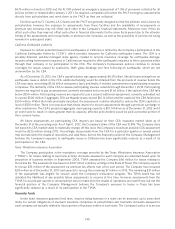 264
264 -
 265
265 -
 266
266 -
 267
267 -
 268
268 -
 269
269 -
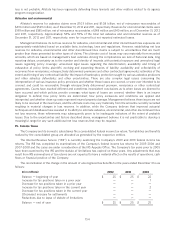 270
270 -
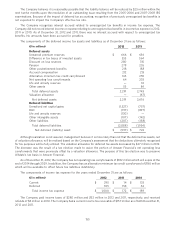 271
271 -
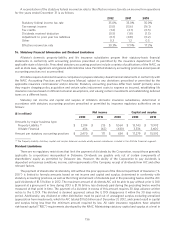 272
272 -
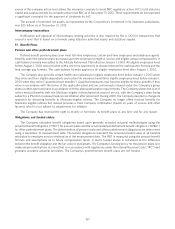 273
273 -
 274
274 -
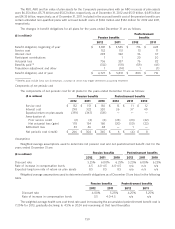 275
275 -
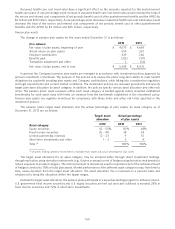 276
276 -
 277
277 -
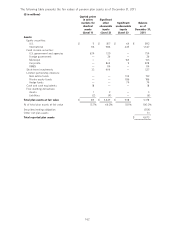 278
278 -
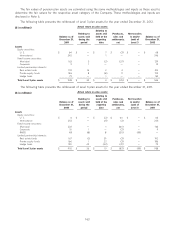 279
279 -
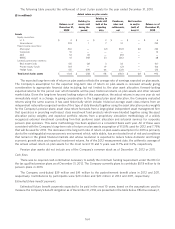 280
280 -
 281
281 -
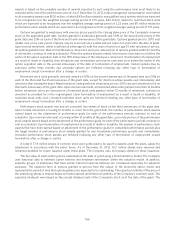 282
282 -
 283
283 -
 284
284 -
 285
285 -
 286
286 -
 287
287 -
 288
288 -
 289
289 -
 290
290 -
 291
291 -
 292
292 -
 293
293 -
 294
294 -
 295
295 -
 296
296
 |
 |
excess of the company action level allows the insurance company to avoid RBC regulatory action. AIC’s total statutory
capital and surplus exceeds its company action level RBC as of December 31, 2012. These requirements do not represent
a significant constraint for the payment of dividends by AIC.
The amount of restricted net assets, as represented by the Corporation’s investment in its insurance subsidiaries,
was $25 billion as of December 31, 2012.
Intercompany transactions
Notification and approval of intercompany lending activities is also required by the IL DOI for transactions that
exceed a level that is based on a formula using statutory admitted assets and statutory surplus.
17. Benefit Plans
Pension and other postretirement plans
Defined benefit pension plans cover most full-time employees, certain part-time employees and employee-agents.
Benefits under the pension plans are based upon the employee’s length of service and eligible annual compensation. A
cash balance formula was added to the Allstate Retirement Plan effective January 1, 2003. All eligible employees hired
before August 1, 2002 were provided with a one-time opportunity to choose between the cash balance formula and the
final average pay formula. The cash balance formula applies to all eligible employees hired after August 1, 2002.
The Company also provides certain health care subsidies for eligible employees hired before January 1, 2003 when
they retire and their eligible dependents and certain life insurance benefits for eligible employees hired before January 1,
2003 when they retire (‘‘postretirement benefits’’). Qualified employees may become eligible for these benefits if they
retire in accordance with the terms of the applicable plans and are continuously insured under the Company’s group
plans or other approved plans in accordance with the plan’s participation requirements. The Company shares the cost of
retiree medical benefits with non Medicare-eligible retirees based on years of service, with the Company’s share being
subject to a 5% limit on annual medical cost inflation after retirement. During 2009, the Company decided to change its
approach for delivering benefits to Medicare-eligible retirees. The Company no longer offers medical benefits for
Medicare-eligible retirees but instead provides a fixed Company contribution (based on years of service and other
factors), which is not subject to adjustments for inflation.
The Company has reserved the right to modify or terminate its benefit plans at any time and for any reason.
Obligations and funded status
The Company calculates benefit obligations based upon generally accepted actuarial methodologies using the
projected benefit obligation (‘‘PBO’’) for pension plans and the accumulated postretirement benefit obligation (‘‘APBO’’)
for other postretirement plans. The determination of pension costs and other postretirement obligations are determined
using a December 31 measurement date. The benefit obligations represent the actuarial present value of all benefits
attributed to employee service rendered as of the measurement date. The PBO is measured using the pension benefit
formula and assumptions as to future compensation levels. A plan’s funded status is calculated as the difference
between the benefit obligation and the fair value of plan assets. The Company’s funding policy for the pension plans is to
make annual contributions at a level that is in accordance with regulations under the Internal Revenue Code (‘‘IRC’’) and
generally accepted actuarial principles. The Company’s postretirement benefit plans are not funded.
157
